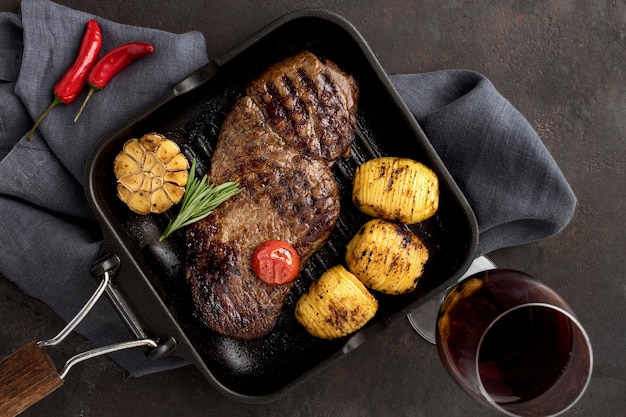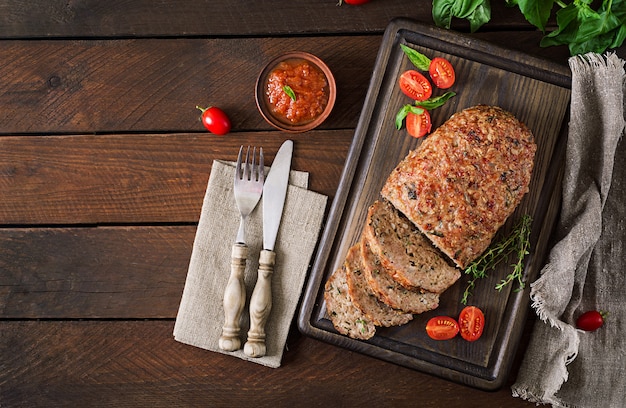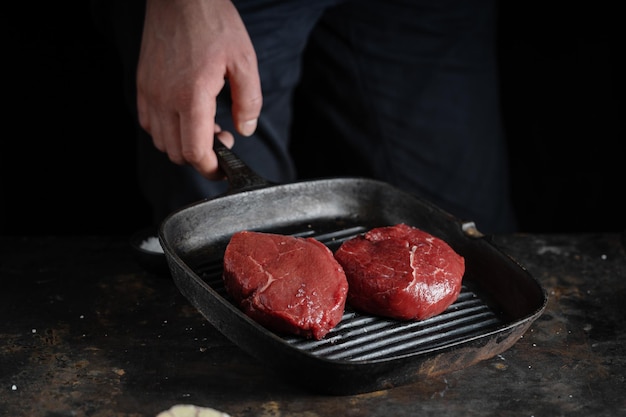(Part 1) Choosing the Right Brisket

The Cut: A Tale of Two Brisket Parts
First things first, we need to talk about the cut. The brisket comes in two main parts: the point and the flat. The point, the more heavily marbled and fatty part, is known for its amazing tenderness and flavour. It's the ultimate indulgence, but it can be a bit rich for some. The flat, on the other hand, is leaner and more even, making it ideal for slicing. It's the workhorse of the brisket world, providing a satisfyingly meaty bite.
Now, for the perfect balance of flavour and texture, I always go for the whole packer brisket – it's the point and flat combined. This gives you the best of both worlds, a beautiful mix of tenderness and leanness. That's the hero we're working with today.
Size Matters: Finding the Right Fit
Size is crucial. You want a brisket that's big enough to feed your crew, but not so big that it takes forever to cook. A good rule of thumb is about 10-12 pounds for a decent-sized family. Remember, you can always make extra and freeze it for later, so don't be afraid to go a little bigger if you’re planning on a big feast.
Quality Counts: Spotting a Good Brisket
Finally, the quality of your brisket is paramount. Look for a cut that's well-marbled, with a good colour and no obvious blemishes. A well-marbled brisket will be juicy and flavorful, while a pale one might be lean and dry. If you're lucky enough to have a butcher you trust, ask them for their recommendation. They'll have a good eye for a quality cut and can guide you to the perfect brisket.
(Part 2) Preparing the Brisket: From Trim to Rub

Trimming the Fat: Finding the Sweet Spot
Okay, you've got your brisket home, now it's time for a little pre-game prep. The first step is trimming the excess fat. Don't go crazy here, though! We want to leave a nice layer of fat (about a ?? inch) to keep the brisket moist during cooking. Think of it as a natural insulator, protecting the meat from drying out. Just trim off any thick, uneven patches or any parts that look a bit too gnarly.
Rub It Down Good: Creating a Flavor Explosion
Now comes the fun part: seasoning! A good dry rub is the key to creating a brisket that's bursting with flavour. A basic rub with salt, pepper, garlic powder, onion powder, paprika, and a little bit of brown sugar is a fantastic starting point.
Don't be afraid to experiment with other spices like chili powder, cumin, or thyme. I personally love a homemade rub that includes a touch of smoked paprika for a deeper, smoky flavour. Get creative, explore, and find the rub that speaks to your palate! Just remember, you can always add more seasoning later, but you can't take it away, so start with a moderate amount and taste as you go.
Rub the dry mixture all over the brisket, making sure to get into all the nooks and crannies. Use your fingers to really work the rub in, massaging it into the meat. Let it sit for at least 30 minutes, allowing the spices to permeate the surface of the brisket.
The Wrap: A Debate Over Moisture
Now we come to a classic brisket debate: to wrap or not to wrap? This decision can make a big difference in the final texture and appearance of your brisket.
- The "No Wrap" Crew: These folks prefer to cook the brisket unwrapped throughout the entire process. This method results in a beautiful bark, a crispy, caramelized crust on the outside that adds a satisfying crunch.
- The "Wrap It Up" Gang: They believe that wrapping the brisket in foil or butcher paper during the latter stages of cooking helps to trap moisture and steam, resulting in a more tender and juicy brisket.
Personally, I'm a member of the "Wrap It Up" Gang. I find that wrapping the brisket for the last few hours helps to ensure that it stays juicy and tender. However, if you're a bark aficionado, then go for the "No Wrap" method.
If you're going the wrap route, you'll need to create a "packet". Take a large piece of foil or butcher paper and place your brisket in the centre. Fold the edges of the foil or paper over the brisket, creating a sealed packet. You can use a bit of twine to secure the packet, but I prefer to just fold the edges really tightly.
(Part 3) The Oven-Baked Brisket Journey: A Slow and Steady Process

Setting the Stage: The Perfect Oven Environment
Alright, it's showtime! Preheat your oven to 325°F (160°C). Remember, low and slow is the name of the game here. We want to give the brisket plenty of time to break down and become incredibly tender.
The First Act: Initial Cooking and Temperature Checks
Place your seasoned brisket (wrapped or unwrapped) on a roasting rack in a large roasting pan. You'll want a pan that's big enough to accommodate the brisket without it touching the sides.
Now, here comes a little trick that I learned from my grandma: fill the bottom of the pan with about a cup of water. This helps to create a humid environment, which prevents the brisket from drying out.
Pop the brisket into the oven and let it cook for about 3-4 hours. At this point, it's time for a temperature check. You're looking for an internal temperature of about 160°F (71°C). Use a meat thermometer to get an accurate reading. If the temperature isn't quite there yet, give it a little more time.
The Second Act: Wrapping, Reducing Heat, and Patience
After 3-4 hours, it's time for the big reveal (and potentially a little more cooking). If you've opted to wrap the brisket, now is the time to do it. If you're going "No Wrap", you can keep cooking it uncovered.
Reduce the oven temperature to 250°F (121°C) and continue cooking until the brisket reaches an internal temperature of about 200°F (93°C). This might take another 3-4 hours, but it's worth it! The lower temperature allows the brisket to cook slowly and evenly, ensuring it's incredibly tender and juicy.
During this stage, you might notice some liquid collecting in the bottom of the pan. This is perfectly normal and a sign that the brisket is releasing moisture. If the liquid evaporates, you can add a little more water to the pan to keep the environment moist.
The Finale: Resting for Maximum Tenderness
Once your brisket has reached that magical 200°F, it's time for the final act. Take the brisket out of the oven and let it rest for at least 30 minutes before carving. This allows the juices to redistribute throughout the meat, making it even more tender and juicy. It's like a final act of transformation, bringing the brisket to its peak of perfection.
(Part 4) Carving the Brisket: A Slice of Success
After that long wait, it's time to enjoy the fruits of your labor. Carving a brisket can seem a little daunting, but it's actually quite simple.
Here's what I do:
- Use a sharp knife: A dull knife will only make the job more difficult and result in uneven slices. A sharp knife makes for clean, even cuts.
- cut across the grain: This is the key to a tender and easy-to-chew brisket. Cutting across the grain helps to break down the muscle fibers.
- Separate the point and flat (if using a whole packer brisket): The point will be more tender and fall apart easily, while the flat will be more firm.
- Slice the brisket into thin, even pieces: You can adjust the thickness of the slices depending on your preference. Thin slices are perfect for sandwiches or tacos, while thicker slices are ideal for serving on a platter.
And that's it! You've now got a perfectly cooked, tender, juicy brisket ready to be devoured.
(Part 5) Serving Up the Brisket: Endless Possibilities
Now that your brisket is cooked to perfection, it's time to start thinking about how you're going to serve it. The options are endless, but here are a few ideas to get you started:
- Brisket Sandwiches: A classic for a reason! Pile high with brisket, coleslaw, and your favorite sauce on a toasted bun. You can even add a touch of pickles or onions for extra flavour.
- Brisket Tacos: This is a fun and delicious way to enjoy brisket, especially when you're looking for something a little more casual. Top your tacos with brisket, onions, cilantro, and salsa.
- Brisket Nachos: A perfect party snack! Layer tortilla chips with brisket, cheese, beans, and your favorite toppings. Get creative with your toppings – jalapenos, sour cream, guacamole… the possibilities are endless!
- Brisket Pizza: Get creative with your toppings! Brisket, barbecue sauce, onions, peppers, and mozzarella cheese make a delicious combination. You can also add a touch of smoked cheddar for extra flavour.
Of course, you can also just serve your brisket plain with a side of mashed potatoes, green beans, or cornbread. Whatever you choose, be sure to enjoy!
(Part 6) Keeping the Brisket Warm: Making It Last
If you're hosting a party, you'll want to keep your brisket warm until it's time to serve it. Here are a few tips to ensure it stays hot and delicious:
- slow cooker: Transfer the brisket to a slow cooker and keep it on low heat. This is a great option if you're going to be serving the brisket over a longer period of time.
- Oven: Preheat your oven to 200°F (93°C) and place the brisket in a roasting pan. Cover the pan with foil to help keep the brisket moist. This method is perfect for keeping the brisket warm while you're finishing up other preparations.
- Chafing Dish: A chafing dish is a great way to keep food warm for a long time. Simply place the brisket in a chafing dish and keep it on low heat. This is a great option for larger gatherings where you want to keep the brisket warm and accessible.
Just remember, whatever method you choose, make sure to keep the brisket covered to prevent it from drying out.
(Part 7) Making the Most of Leftover Brisket: Transforming Deliciousness
Let's be honest, leftovers are the best part of brisket. It's like a gift that keeps on giving! Here are some ideas for turning those leftovers into a delicious meal:
- Brisket Hash: Chop up your leftover brisket and combine it with potatoes, onions, and your favorite spices. Fry it all up in a pan and you've got a delicious and hearty breakfast.
- Brisket Soup: Add your leftover brisket to a pot of broth and vegetables and you've got a comforting and flavorful soup. This is a great way to use up the last of the brisket and make a warm and satisfying meal.
- Brisket Chili: Use your leftover brisket to make a hearty and flavorful chili. Add beans, tomatoes, and spices for a satisfying meal. You can even add a little cornbread for a complete meal.
- Brisket Quesadillas: Layer your leftover brisket with cheese and your favorite toppings in a tortilla and grill it to perfection. A quick and easy meal that's perfect for a busy weeknight.
The possibilities are endless! Just get creative and enjoy those leftovers.
(Part 8) A Little Something Extra: Barbecue Sauce
Let's be honest, brisket and barbecue sauce are a match made in heaven. If you're going to be serving your brisket with sauce, you'll want to choose one that complements the flavour of the meat.
Here are a few of my favorite barbecue sauces, each with its own distinct flavour profile:
- Kansas City Style Barbecue Sauce: This sauce is typically made with tomato, brown sugar, and molasses. It has a sweet and smoky flavour that pairs well with brisket.
- Texas Style Barbecue Sauce: This sauce is usually thinner and more tangy than Kansas City style sauce. It's made with vinegar, black pepper, and sometimes mustard. The vinegar adds a bright tang that cuts through the richness of the brisket.
- Carolina Style Barbecue Sauce: This sauce is known for its tangy vinegar base. It often includes mustard, black pepper, and sometimes a touch of sweetness. The vinegar adds a sharp bite, while the mustard provides a subtle, savory note.
You can find a wide variety of barbecue sauces at your local grocery store. Or, if you're feeling ambitious, you can try making your own. There are plenty of recipes online! Just remember, the best sauce is the one that you enjoy the most.
Personally, I prefer a thicker, sweeter sauce with a smoky flavour. I always have a bottle of my homemade sauce on hand, which includes a touch of molasses for a deep, rich flavour. It's a bit of a secret family recipe, so you'll have to experiment and find your own perfect sauce.
(Part 9) Brisket 101: The Dos and Don'ts
After all this brisket talk, I'm sure you're eager to get started. But before you head to the kitchen, let's go over a few dos and don'ts to ensure your brisket masterpiece is a success:
Dos:
- Do use a high-quality brisket. Don't settle for anything less.
- Do trim the excess fat. This will help to prevent the brisket from being overly greasy.
- Do use a good dry rub. This is what will give your brisket that amazing flavour.
- Do cook the brisket low and slow. This is the key to tender and juicy brisket.
- Do wrap the brisket in foil or butcher paper during the last few hours of cooking (optional). This helps to trap moisture and steam.
- Do let the brisket rest for at least 30 minutes before carving. This allows the juices to redistribute.
- Do use a sharp knife to carve the brisket. This will make the job easier and result in even slices.
- Do serve your brisket with your favorite sides. This will create a complete and satisfying meal.
Don'ts:
- Don't overcook the brisket. Overcooked brisket will be dry and tough.
- Don't skip the resting time. This is crucial for a tender and juicy brisket.
- Don't use a dull knife to carve the brisket. A dull knife will make the job more difficult and result in uneven slices.
- Don't be afraid to experiment with different seasonings and cooking methods. The best way to learn is to try new things!
Now, you're ready to conquer the world of brisket. Remember, practice makes perfect, so don't be discouraged if your first attempt isn't exactly perfect. With a little patience and practice, you'll be a brisket master in no time!
(Part 10) FAQs: Addressing Common Questions
1. Can I use a cheaper cut of beef for brisket?
While you can technically use a cheaper cut of beef, it won't be as tender and flavorful. Brisket is a tough cut of meat, and it requires a long, slow cooking process to break down the connective tissue. If you use a cheaper cut, it's likely to be tough and chewy. Stick with a high-quality brisket for the best results.
2. What temperature should the brisket be cooked to?
The ideal internal temperature for a brisket is about 200°F (93°C). This ensures that the meat is cooked through and tender. You can check the temperature of the brisket using a meat thermometer.
3. How long should I cook the brisket?
The cooking time for a brisket will vary depending on the size and thickness of the cut. A general rule of thumb is to cook it for about 1 hour per pound at 325°F (160°C), then reduce the temperature to 250°F (121°C) and continue cooking until the brisket reaches an internal temperature of 200°F (93°C).
4. Can I cook brisket in a smoker?
Absolutely! Brisket is a classic smoker dish. The low and slow heat of a smoker helps to break down the connective tissue in the meat, resulting in a tender and juicy brisket. The smoke adds a unique and delicious flavour to the brisket.
5. What happens if I overcook the brisket?
If you overcook the brisket, it will become dry and tough. It's important to cook the brisket to the right temperature and to keep an eye on it throughout the cooking process. If you're worried about overcooking the brisket, you can always wrap it in foil or butcher paper for the last few hours of cooking.
There you have it! The complete guide to oven-baked brisket, from choosing the right cut to serving it up in style. Now, go forth and conquer!
Everyone is watching

How to Cook Frozen Lobster Tails Perfectly: A Step-by-Step Guide
RecipesLobster. Just the word conjures up images of lavish meals, special occasions, and a taste of luxury. But let's...

Pigs in a Blanket Cooking Time: How Long to Bake for Perfect Results
RecipesAh, pigs in a blanket. Just the name conjures up images of those delightful little parcels of crispy pastry en...

Pork Fillet Cooking Time: How Long to Cook It Perfectly
RecipesPork fillet, or tenderloin as it's sometimes called, is a real favourite in our house. It's so versatile, and...

The Ultimate Guide to Cooking Delicious Frankfurters
RecipesLet's face it, we all love a good frankfurter. It's a classic, simple, and always satisfying. But let's be rea...

Wolf Meat Recipes: A Guide to Cooking Wild Game
RecipesLet's be honest, you don't see wolf meat at your local butcher shop every day. It's a bit of a wild card, but ...
